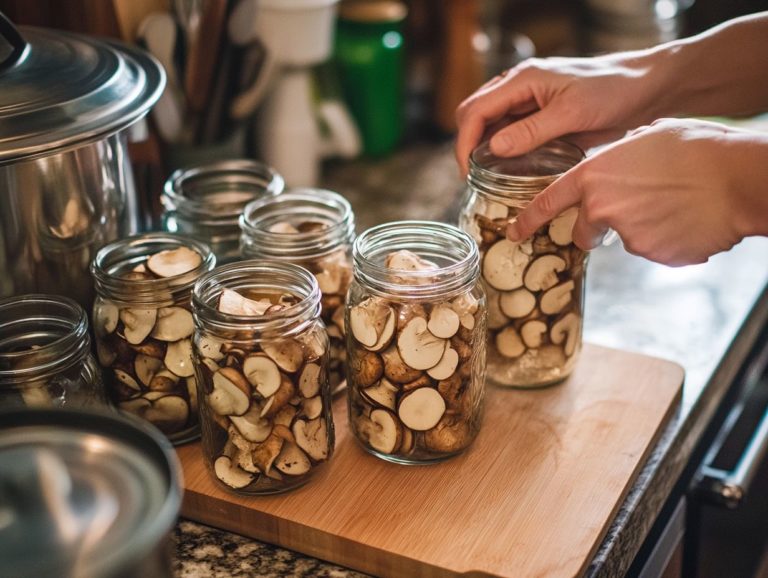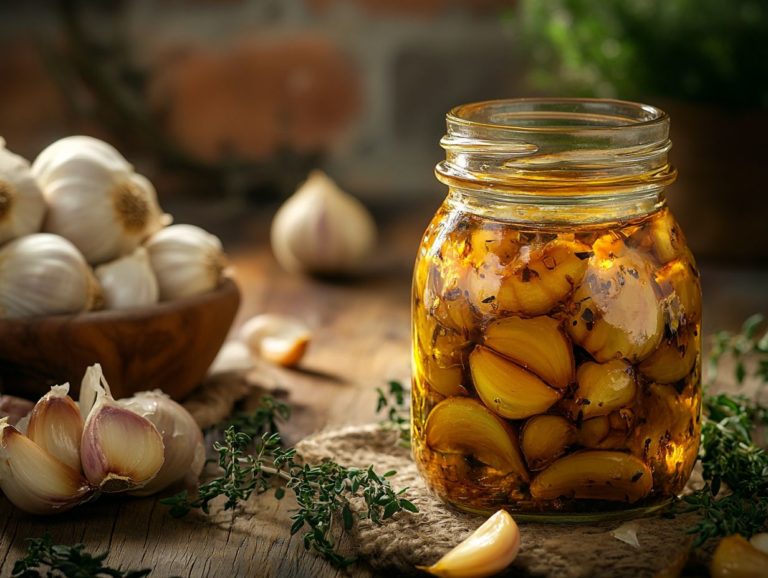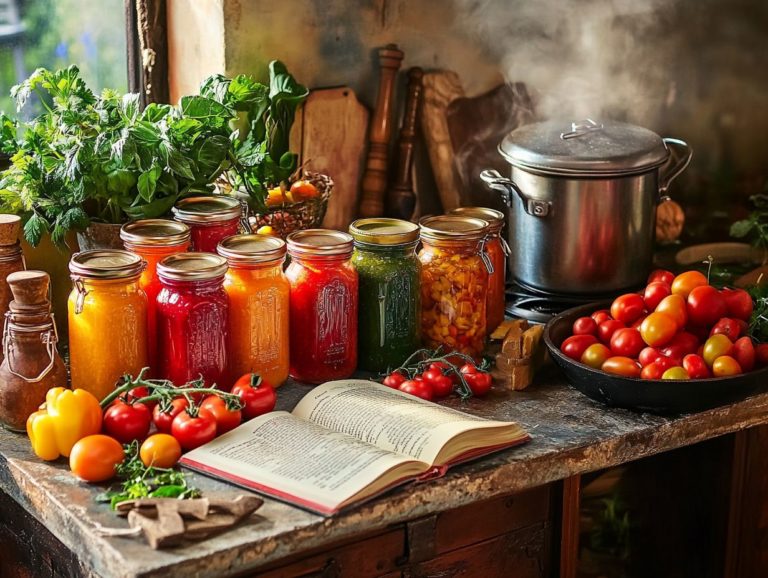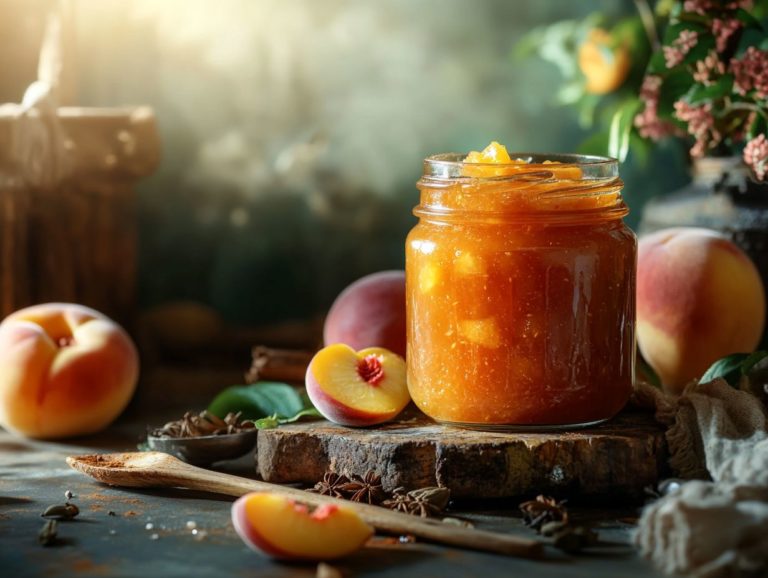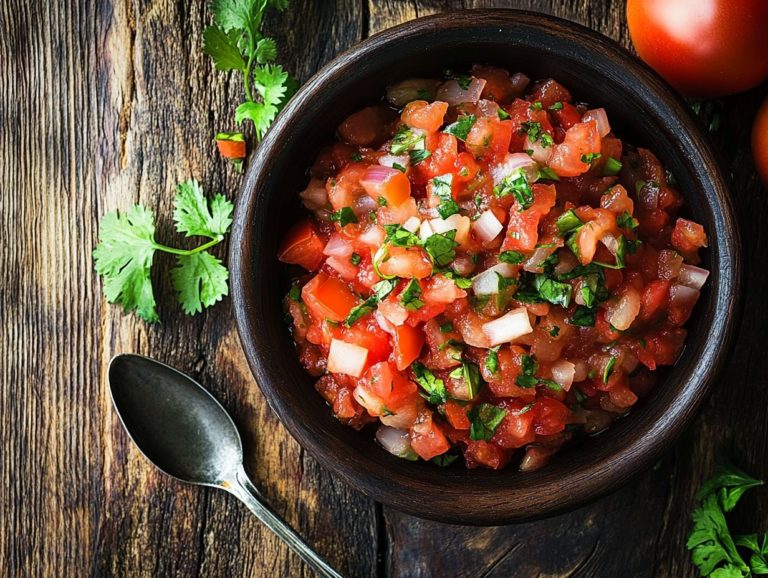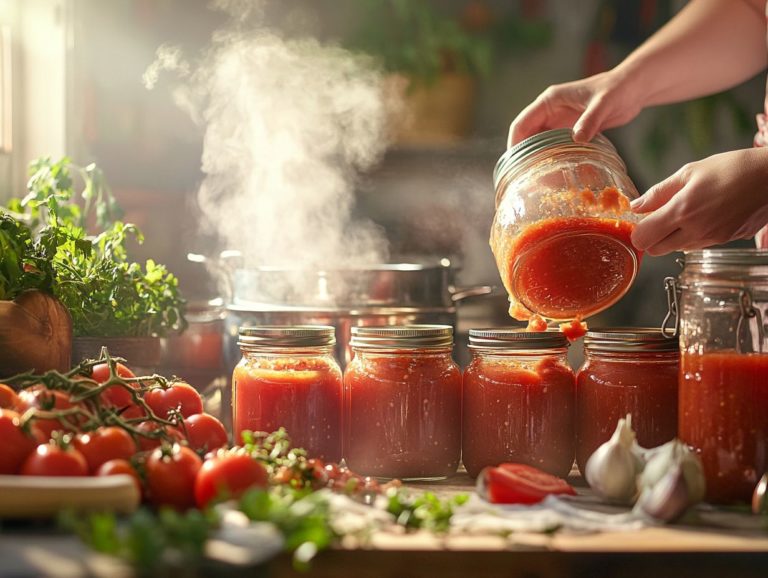9 Creative Canning Recipes for Leftovers
Tired of tossing out leftover food? Transform those uneaten meals into tasty canned meals! This not only combats waste but also expands your cooking options, allowing you to try out various canning recipes that taste great and make the most of your favorite dishes.
Discover nine inventive canning recipes that breathe new life into your leftovers, ranging from hearty soups to zesty marinades.
Delve into the benefits of canning, complete with essential tips for safe practices and innovative strategies to save both money and food. Get ready to transform your meals and elevate your kitchen game!
Contents
- Key Takeaways:
- 1. Leftover Chicken and Vegetable Soup
- 2. Spicy Salsa Verde
- 3. Curried Lentil and Vegetable Stew
- 4. Tangy Pickled Vegetables
- 5. Savory Tomato and Basil Jam
- 6. Sweet and Spicy Pineapple Chutney
- 7. Creamy Cauliflower and Cheese Soup
- 8. Zesty Lemon and Herb Marinade
- 9. Roasted Vegetable and Bean Dip
- What Are the Benefits of Canning Leftovers?
- Frequently Asked Questions
- What are some creative canning recipes for using up leftovers?
- How can I use up leftover meat in canning recipes?
- Can I use leftover pasta in canning recipes?
- What are some unique ways to use up leftover rice in canning recipes?
- Are there any canning recipes specifically for using up leftover holiday dishes?
- Can I use leftover bread in canning recipes?
Key Takeaways:
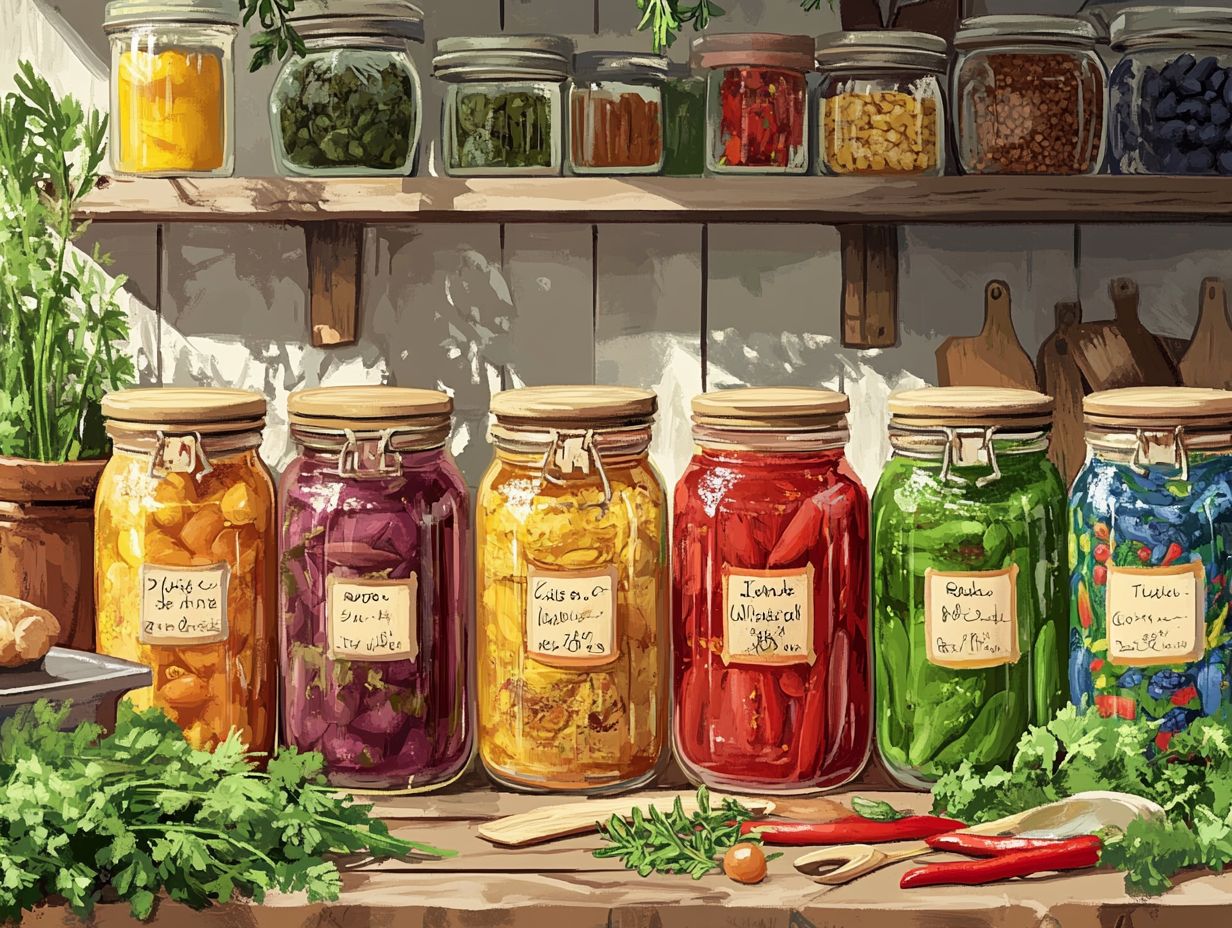
- Turn your leftovers into mouthwatering meals get creative!
- Save money and cut waste with these canning tips.
- Stay safe by following canning guidelines for delicious results.
1. Leftover Chicken and Vegetable Soup
Use your leftover chicken and veggies to make a hearty soup. This dish combines tender chicken and seasonal vegetables.
Carrots, celery, and onions add flavor and nutrients, making this soup a healthy choice. Plus, it cans well for future meals.
To ensure safety during the canning process, use a special pot that helps preserve low-acid foods safely for this chicken soup. The National Center for Home Food Preservation and the Ball Complete Book of Home Preserving highlight the importance of maintaining proper heat and timing. By following these guidelines, you can create hearty pots of soup that are not only enjoyable to savor but also safe to store for whenever those cravings hit.
2. Spicy Salsa Verde
Spicy Salsa Verde is a tangy addition to any meal. Follow these canning tips to enjoy your homemade salsa for longer.
Key ingredients like tomatillos and jalape os deliver a fresh burst of flavor. Enjoy it as a dip or drizzle it on dishes.
For safe canning, use clean, sterilized jars and lids, and process the salsa in a boiling water bath for the recommended time to eliminate any potential pathogens. Adhering to these safety best practices allows you to savor your homemade spicy salsa verde year-round without a hint of worry.
3. Curried Lentil and Vegetable Stew
Curried Lentil and Vegetable Stew is a warm, hearty meal that s great for canning. You ll always have a delicious option ready to go.
Use canned veggies like diced tomatoes and green beans for nutrition and flavor. Spices like curry powder and cumin enhance the taste.
To can the stew effectively, use sterilized jars and ensure the mixture reaches a boiling point before sealing. This method locks in essential flavors and nutrients, transforming each jar into a convenient and delicious option for those busy days ahead.
Dive into canning today and make the most of your leftovers!
4. Tangy Pickled Vegetables
Tangy Pickled Vegetables offer you a great way to preserve vibrant seasonal flavors. Canning transforms fresh ingredients into delicious homemade delights that are safe to store.
You can explore a variety of vegetables, like cucumbers, carrots, and radishes, each bringing its own unique textures and flavors to the table. The pickling process starts with a straightforward brine of water, vinegar, and salt, which you can enhance with spices like dill or mustard seeds for that extra kick.
To ensure canning safety, it s essential to adhere to approved techniques, such as using sterilized jars and maintaining the right balance of sourness needed for safe canning. Try experimenting with flavor profiles. Adding garlic or chili flakes can elevate the tanginess, transforming ordinary pickles into zesty gourmet treats that beautifully complement your meals.
5. Savory Tomato and Basil Jam
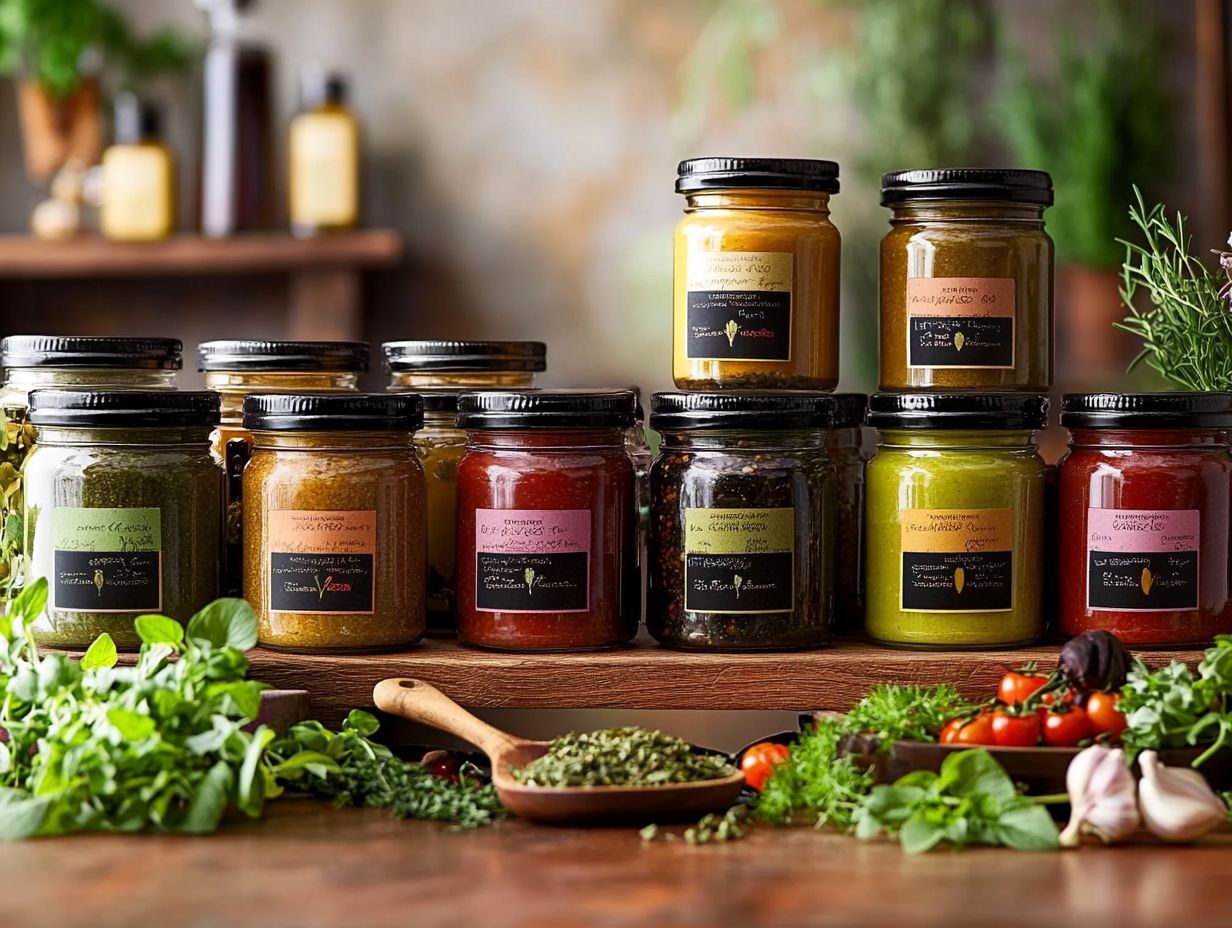
Savory Tomato and Basil Jam is a standout canning recipe that masterfully intertwines the rich flavors of ripe tomatoes with the aromatic essence of fresh basil. This creates a condiment that elevates everything from crusty bread to succulent grilled meats.
To craft this delightful spread, start by selecting the juiciest, ripest tomatoes and the freshest basil leaves. These ingredients are key to achieving the best flavor and texture. Once you’ve diced the tomatoes, combine them with sugar, lemon juice, and chopped basil in a pot, and let the mixture come to a gentle simmer.
Stir occasionally as it thickens, which usually takes about 30 to 40 minutes. If you re ready to embark on your canning adventure, pour the hot jam into sterilized jars, leaving some headspace before sealing them with lids and processing in a boiling water bath for preservation.
This savory jam has the power to elevate a cheese platter, serve as a delightful topping for crostini, or enhance roasted vegetables. Its remarkable versatility showcases the jam across a myriad of dishes.
6. Sweet and Spicy Pineapple Chutney
Sweet and Spicy Pineapple Chutney is an exhilarating blend of flavors that will take your meals to the next level! By using canning recipes, you can create a homemade version that captures the essence of summer all year round.
Crafted with fresh pineapple, a hint of brown sugar, and a medley of spices, this chutney offers a delightful balance of sweenness and heat. The combination of ginger, garlic, and chili peppers introduces a depth that makes it an ideal condiment for meats or a vibrant addition to cheese boards.
To prepare it, begin by chopping the pineapple and simmering it with the spices and sugar until it thickens beautifully. Once it s cooled, can the chutney safely by following recommended sterilization techniques, ensuring a shelf-stable treat that you can savor anytime.
7. Creamy Cauliflower and Cheese Soup
Creamy Cauliflower and Cheese Soup is more than just a comforting dish; it s a delightful option for canning that lets you relish its rich flavors long after it’s made. This ensures safety throughout the canning process.
To prepare this exquisite soup for canning, start by cooking fresh cauliflower until it s tender. Then blend in a selection of cheeses that will give it that luxurious, velvety texture. As the mixture simmers, be sure to stir continuously to achieve the perfect smoothness.
Once the soup has reached that ideal flavor profile, allow it to cool slightly before filling your sterilized jars, making sure to leave enough headspace. When it comes time to seal, ensure the lids are placed correctly to create an airtight seal.
Keep in mind the recommended water-bath canning durations specifically for creamy soups proper processing is crucial for safety. After cooling, don t forget to check the seals; a firm lid is your assurance of successful preservation.
8. Zesty Lemon and Herb Marinade
The Zesty Lemon and Herb Marinade offers a delightful burst of flavor that can elevate your dishes effortlessly. Canning recipes designed for canning allow you to whip up a batch to keep on hand. This way, you can enjoy the advantages of homemade preservation while enhancing your meals with ease.
The bright acidity of lemon pairs exquisitely with herbs like thyme, rosemary, and parsley. This creates a harmonious blend that accentuates the natural flavors of proteins such as chicken, fish, and tofu. When preparing this versatile mixture for canning, it s essential to maintain the right balance of acidity through proper preservation methods. Be sure to use sterilized jars and keep that lemon juice ratio high to ensure safety.
This marinade has the power to transform a simple vegetable dish imagine grilled zucchini or roasted carrots into something truly extraordinary. It s a critical staple for anyone looking to elevate their culinary repertoire.
9. Roasted Vegetable and Bean Dip
Roasted Vegetable and Bean Dip is a delightful snack that truly highlights the art of canning. It shows how you can transform simple recipes into exquisite dips, perfect for entertaining or indulging throughout the week.
To craft this delectable dip, start by selecting a vibrant array of vegetables think bell peppers, zucchini, and eggplant. Roasting these beauties not only enhances their natural sweetness but also adds a rich depth of flavor. By incorporating a blend of white and black beans, you elevate the creaminess while boosting the protein content. Each bite will be satisfying.
Once you’ve blended the roasted vegetables and beans into a smooth puree, it s time to can the dip for extended shelf life. Start by sterilizing your jars. Then, fill them with your tasty mix and seal them tight to lock in those amazing flavors! With this approach, each scoop remains as fresh and delicious as the day it was prepared, ready to impress at any gathering.
What Are the Benefits of Canning Leftovers?
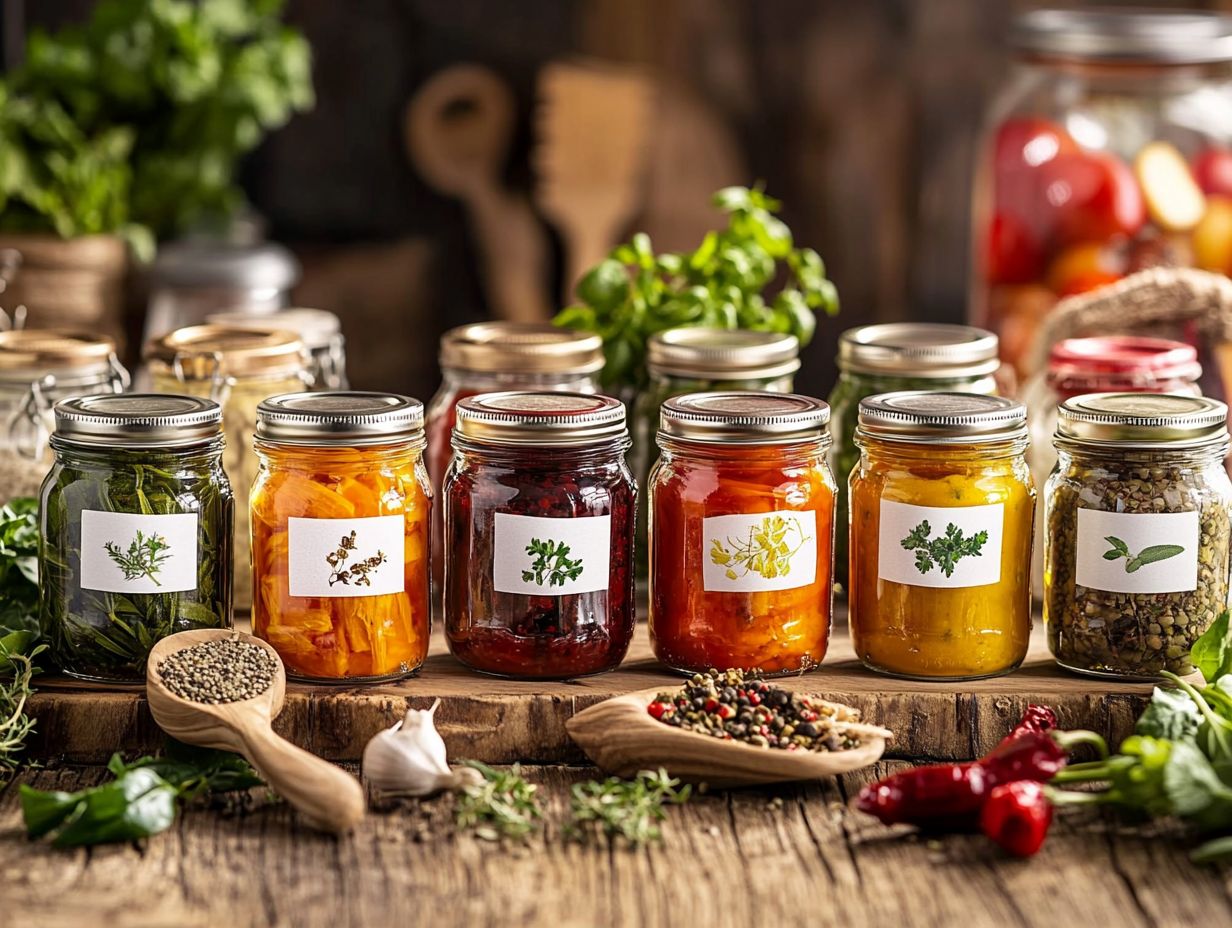
Canning your leftovers has many benefits. It cuts down on food waste and saves you money, while letting you enjoy your favorite recipes later. By adhering to canning safety protocols, you can ensure that every jar bursts with freshness and quality.
This sustainable practice not only helps create a healthier planet by reducing landfill contributions. It also gives you the power to preserve seasonal produce, extending its shelf life and enhancing the variety of meals you can enjoy throughout the year.
Taking advantage of bulk purchases or farm-fresh deals through canning can significantly lower your grocery bills. This practice nurtures a sense of self-sufficiency and inspires creativity in the kitchen.
Imagine the convenience of ready-made meals neatly stored in jars, streamlining your dinner prep on those hectic days. It makes maintaining healthy eating habits effortlessly achievable.
As highlighted by the National Center for Home Food Preservation, employing proper canning methods ensures that your nutrients remain intact. This delivers both economic and nutritional value to your household.
How Can Canning Help Reduce Food Waste?
Canning stands out as an exceptional method for reducing food waste. It enables you to preserve those leftovers that might otherwise end up in the trash. This way, you re not just making the most of your groceries; you re also making a positive impact on the environment.
With nearly one-third of all food produced globally going to waste, the importance of canning becomes glaringly clear. By embracing canning practices, you can extend the shelf life of fruits, vegetables, and other perishables. This plays a crucial role in minimizing your waste footprint.
Engaging in this age-old preservation technique allows you to safeguard produce that s on the brink of spoiling. Transform it into jars filled with colorful, preserved delights. Canning fosters a sense of self-sufficiency and a deeper connection to your food sources, promoting a lifestyle rooted in sustainability and resourcefulness.
Start canning today and enjoy the taste of your meals throughout the year!
What Are Some Tips for Safe Canning?
Safe canning tips are essential for keeping your homemade preserves safe and tasty. Familiarizing yourself with best practices for home preserving is important.
One key factor to keep in mind is the equipment you use. Investing in high-quality canning jars and lids can significantly boost your chances of success.
Keeping things clean is also critical, as any contaminants could jeopardize the safety of your finished product.
Understanding the difference between pressure canning (for low-acid foods) and water bath canning (for high-acid foods) is vital. Each method requires precise handling. For thorough guidance, the National Center for Home Food Preservation offers invaluable resources to help you master the art of home canning while prioritizing safety.
How Can One Get Creative with Canning Leftovers?
Getting creative with canning leftovers opens up a world of possibilities, allowing you to experiment with unique recipes. To learn more, check out this guide on how to use leftovers in canning that transforms everyday ingredients into delightful preserves.
By incorporating unexpected flavor combinations, you can discover delightful surprises that keep mealtime engaging. For instance, transform leftover grilled vegetables into a zesty relish or blend overripe fruits with herbs to craft a fragrant jam that tantalizes your taste buds.
These fun ways not only cut down on food waste but also give your meals a delicious twist! Even leftover wine can be turned into a luscious vinegar, infusing depth into dressings and marinades.
By thinking outside the jar, preserving can become a joyful adventure, invigorating both your pantry and your palate.
What Are Some Other Ideas for Canning Leftovers?
Along with traditional canning recipes, you’ll discover countless innovative ideas for using leftover produce in canning that not only preserve your food but also minimize waste.
Imagine turning leftover vegetables into tangy pickles that bring a delightful crunch to your sandwiches and salads. Instead of letting overripe fruits go to waste, cook them down into sweet jams perfect for slathering on your morning toast.
And those leftover tomatoes, onions, and peppers? You can whip them into sauces and salsas that prevent spoilage and elevate your meals with a burst of homemade flavor.
These creative approaches empower you to significantly reduce waste while embarking on an exciting culinary adventure.
Can Canning Leftovers Save Money?
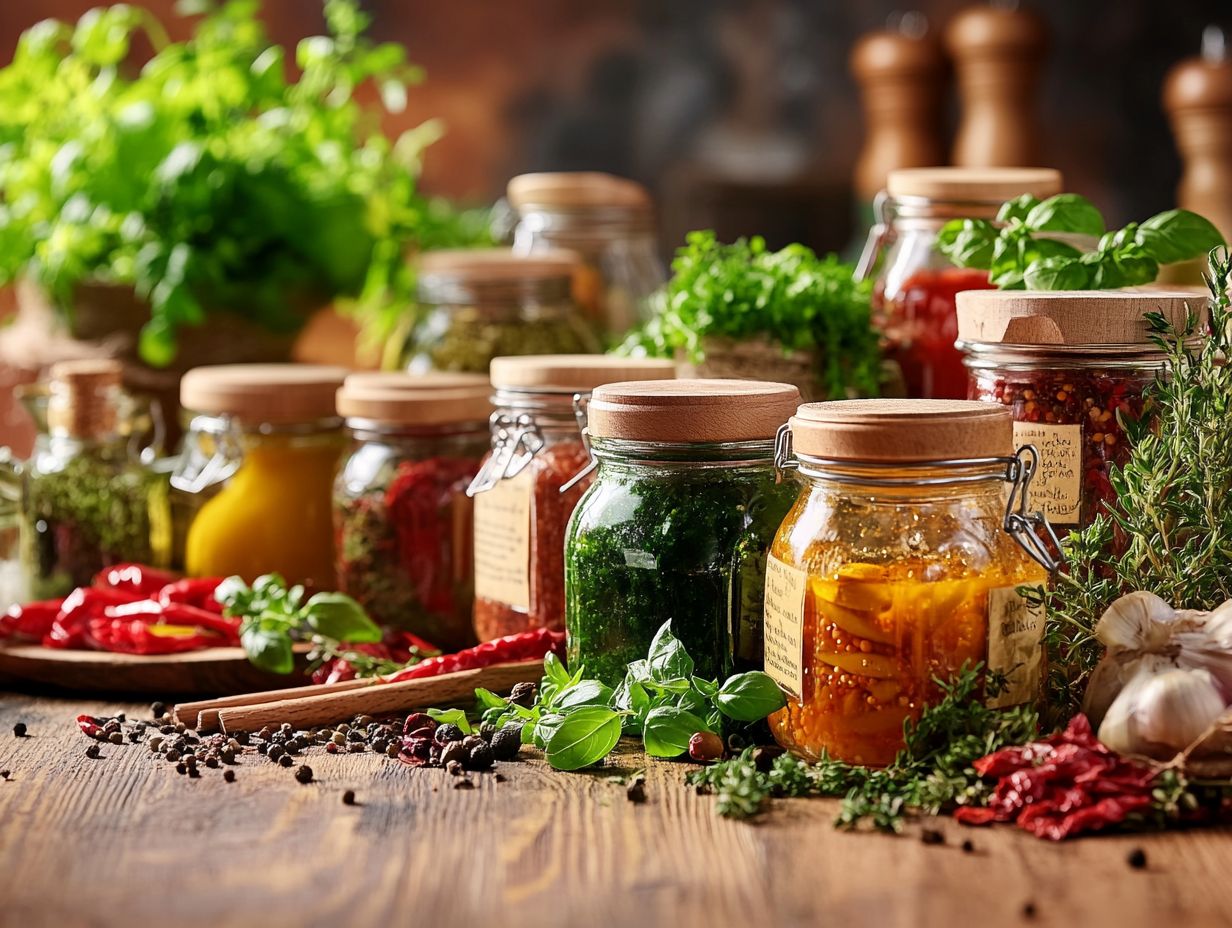
Canning leftovers is a savvy way to save money by extending the shelf life of your food. This allows you to make the most of what you already have instead of constantly replenishing your pantry.
By transforming surplus fruits and vegetables into delectable jars of preserves, you safeguard your investment while enjoying the fruits of your labor all year round. When you consider how much fresh produce often goes to waste due to spoilage, canning emerges as a shrewd financial strategy.
For instance, turning excess tomatoes into sauces or jams can significantly slash your grocery bills, especially during off-seasons when prices tend to skyrocket.
This practice of canning helps minimize waste-related costs, enabling you to spend less on refuse services while also embracing a more sustainable lifestyle.
Frequently Asked Questions
What are some creative canning recipes for using up leftovers?
You can get creative by pickling leftover vegetables, making jam or jelly out of leftover fruits, and exploring fun recipes for canning mixed fruits while creating a homemade tomato sauce using leftover vegetables.
How can I use up leftover meat in canning recipes?
Leftover meat can be used in canning recipes by making a hearty stew or soup that can then be canned for later use. You can also create a meat-based sauce or gravy using leftover meat and can it for future use.
Can I use leftover pasta in canning recipes?
Yes, you can use leftover pasta by making a pasta sauce or salsa using the cooked pasta and canning it for later use. You can also create a canned pasta salad using leftover pasta and vegetables.
Don t let your leftover fruits spoil! Transform them into sweet jams today! Share your canning experiences or recipes in the comments!
What are some unique ways to use up leftover rice in canning recipes?
You can use leftover rice in canning recipes. Try making rice and bean salsa, rice pudding, or a rice and vegetable casserole.
Leftover rice can also be used for homemade sushi filling. This can be canned for later use.
Are there any canning recipes specifically for using up leftover holiday dishes?
Yes, there are recipes for using up leftover holiday dishes. You can preserve cranberry sauce, mashed potatoes, and turkey in jars.
These recipes help you savor holiday flavors at a later time.
Can I use leftover bread in canning recipes?
Yes, leftover bread can be used creatively in canning recipes. Consider making bread and butter pickles or bread pudding.
You can also make jam or jelly with leftover bread and fruit. This can be canned for a unique spread.

